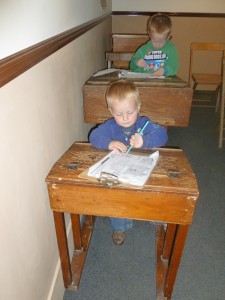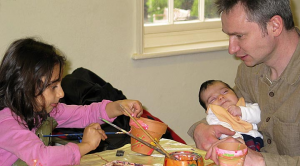 In the Thomas Jefferson Education philosophy, one of the mantras is “structure time, not content.” This idea started a conversation on my Homeschooling Creatively list about what that means to different people and what behaviors might interfere with it being a successful endeavor.
In the Thomas Jefferson Education philosophy, one of the mantras is “structure time, not content.” This idea started a conversation on my Homeschooling Creatively list about what that means to different people and what behaviors might interfere with it being a successful endeavor.
One of the common problems that arise when we think about “structuring time for learning” is that we adults have a conditioned response to turn ourselves into “teacher mode.” What is the main environment that we’re all familiar with where there is “structured time for learning?” School! And what happens in that structured time? Teachers teach. In fact, in school, it’s rarely if ever assumed that children would learn unless a teacher teaches. So, if we try to implement this idea of structured learning TIME, how many of us turn our teacher mode on?
I realize that’s exactly what I did with my firstborn son when we began our homeschooling journey. Up until that point, my son was constantly learning on his own initiation and I consistently facilitated his interests. Once he was about to turn 5, and was supposed to be “officially schooled,” my behaviors completely changed. Suddenly, I had to create a “structured learning time” and I had to become the teacher. I can imagine the confusion of my son at the time. “Did my mother suddenly lose her mind? What’s up with all this forced learning?” He was having nothing to do with it.
 That’s when my fourth child was born, and where I came up with the saying, “The birth of my fourth child saved the education of my first.” Because I no longer had time to be in formal teacher mode, he could go back to his self-initiated learning rhythm. And I could go back to my support facilitator role that had worked so well in the beginning.
That’s when my fourth child was born, and where I came up with the saying, “The birth of my fourth child saved the education of my first.” Because I no longer had time to be in formal teacher mode, he could go back to his self-initiated learning rhythm. And I could go back to my support facilitator role that had worked so well in the beginning.
This is a key component to unschooling. It’s about assuming that the entire day is set up to be learning time. The Thomas Jefferson Education philosophy appears to be a marriage of unschooling and classical education. Thus, the reason for the “structure time” element is for the classical education part, the part of us who feels a need to have a “learning time” set apart, like we’re used to seeing in school. And the “not content” part is the unschooling element, where passion-inspired, interest-based learning is encouraged.
I see the biggest challenge of deciding to “structure time” is learning not to be in teacher mode. Instead, it’s about being available. How hard is it for us to create a learning time and space, and then just BE…be a listening ear, be a reader for a non-reader, be interested, be willing to play, be willing to watch. It tends to go against our conditioned nature to DO instead of BE. That’s what happened to me after giving birth to my fourth child. Taking care of and nursing a baby requires a lot of being still. So, I would sit in my rocking chair with the baby and just BE with my other three children as they explored, discovered, and learned. I was  available to read, I was available to be interested, I was available to conversate, I was available to observe how they learned. I learned a lot in my “be still with a newborn stage” that helped me shift from needing to be in teacher mode (which had ended quite badly…see that post I linked to earlier), to being in available and observant mode.
available to read, I was available to be interested, I was available to conversate, I was available to observe how they learned. I learned a lot in my “be still with a newborn stage” that helped me shift from needing to be in teacher mode (which had ended quite badly…see that post I linked to earlier), to being in available and observant mode.
There are all sorts of benefits to learning while in available and observant mode. Over at Wonder Farm, blogger Patricia Zaballos gives an example in her post about how being available to have conversations with your children about their interests leads to good writing ability. I found out later that first year of homeschooling through my “lesson of the snake unit” that being available to  answer questions, read excerpts, and get resources allowed my son to learn far more than he could from a prepared teacher lesson. I know I sometimes needed to find an outlet for my need to DO and organize, so I would record my observations that first few years. (I will look into transcribing some of those onto the website somewhere.)
answer questions, read excerpts, and get resources allowed my son to learn far more than he could from a prepared teacher lesson. I know I sometimes needed to find an outlet for my need to DO and organize, so I would record my observations that first few years. (I will look into transcribing some of those onto the website somewhere.)
The thing is, the more I practiced being available and being observant, the easier it became, especially as you got to witness the details of the learning process of your children. I do find that in my busy times these days, I’m allowing myself to be less available. It takes effort and commitment to do it. For my two youngest, it’s crucial that I prioritize it for their growth and learning. So much more rich engagement occurs for them when I’m available to them. Our relationships deepen so much more when I’m available. Trust and respect are nurtured when I’m available. It’s good stuff!
Question: What did you discover about yourself or your children when you were more available or more observant of them as they learn?






Pingback: Your Child Might Be Right-Brained If … | The Right Side of Normal